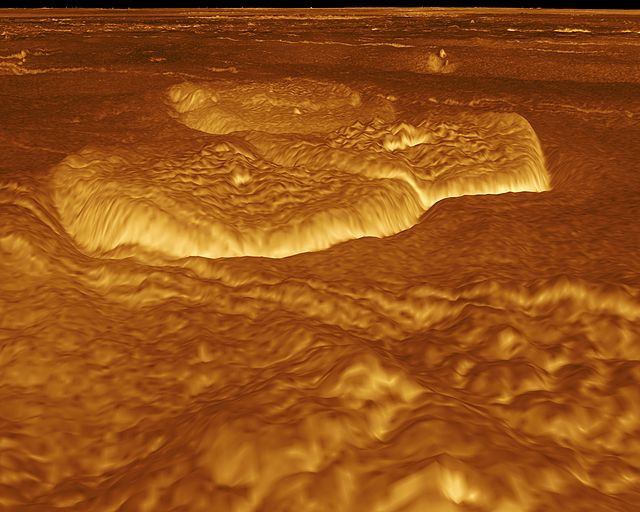The surface of Venus is dominated by volcanic features and has more volcanoes than any other planet in the Solar System. It has a surface that is 90% basalt, and about 65% of the planet consists of a mosaic of volcanic lava plains, indicating that volcanism played a major role in shaping its surface. There are more than 1,000 volcanic structures and possible periodic resurfacing of Venus by floods of lava. The planet may have had a major global resurfacing event about 500 million years ago, from what scientists can tell from the density of impact craters on the surface. Venus has an atmosphere rich in carbon dioxide, with a pressure that is 90 times that of Earth's atmosphere.
The second highest mountain and highest volcano of Venus, the 8-km-high (5-mile-high) volcano Maat Mons, is displayed in this perspective view of the surface of Venus, with the vertical scale multiplied by 22.5. Based on Magellan radar images. In the foreground, long lava flows are visible.
Radar mosaic of two 65 km (40 mi) wide (and less than 1 km (0.62 mi) high) pancake domes in Venus's Eistla region
Computer-generated perspective view of pancake domes in Venus's Alpha Regio
Venus is the second planet from the Sun. It is a terrestrial planet and is the closest in mass and size to its orbital neighbour Earth. Venus is notable for having the densest atmosphere of the terrestrial planets, composed mostly of carbon dioxide with a thick, global sulfuric acid cloud cover. At the surface it has a mean temperature of 737 K and a pressure of 92 times that of Earth's at sea level. These extreme conditions compress carbon dioxide into a supercritical state close to Venus's surface.
True colour image of Venus, as captured by MESSENGER. A global layer of bright sulfuric acid clouds permanently obscures the Venusian surface.
Venus to scale among the terrestrial planets of the Solar System, which are arranged by the order of their Inner Solar System orbits outward from the Sun (from left: Mercury, Venus, Earth and Mars)
Surface of Venus as seen by Venera 13.
Radar mosaic of two 65 km (40 mi) wide (and less than 1 km (0.62 mi) high) pancake domes in Venus's Eistla region






